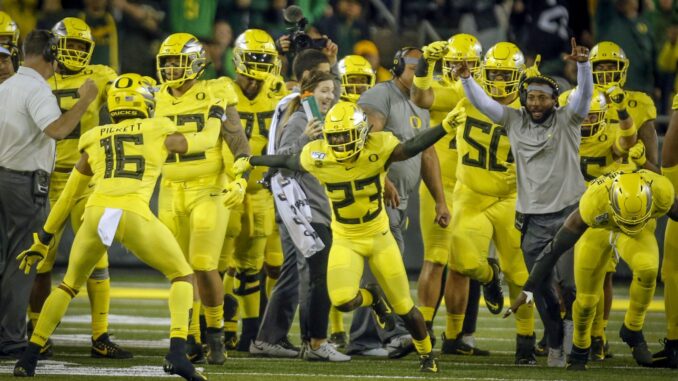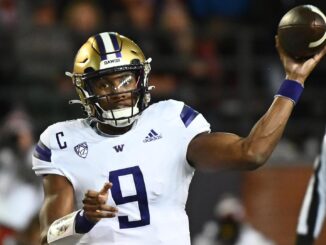
Now that 2021 recruiting is completed, we can look at how teams did in 2021, compare that to 2020, see which teams have the strongest four-year rosters, and look at trends that can predict how long new coaches will last.
I will be using data from 247sports, but unlike that publication, I won’t be basing this analysis on their composite of the number of recruits multiplied by the average value per recruit. Over the years in preparing to predict games, I’ve discovered that composites of that sort become unreliable when teams such as Oregon State don’t have a full set of scholarships to offer. Instead, I’ve found that all recruits’ average value produces much better results in preseason assessments. We’ll use that average, incorporate the number of recruits who are probable difference makers (four or five-star players) and discuss noteworthy trends.
Let’s take a look at the PAC-12 teams in alphabetic sequence with that in mind.
ARIZONA
2021 average recruit: 83.46 (12th in PAC-12; 76th nationally)
Four year average: 84.35 (12th in PAC-12; 66th nationally)
Number of difference makers: None
Jedd Fisch is the new head coach for the Wildcats. There wasn’t much of a buzz about his hiring, although there was a modest stir when he hired Don Brown as defensive coordinator because Brown’s most recent tenure was that of defensive coordinator at Michigan.
However, as fans looked closer, they discovered that Michigan had fired Brown in December because his defenses had regressed in each of his four years, and his recruiting had left the Wolverines “porous and hurt by inexperience.”
Fisch filled the offensive coordinator’s position with Brennan Carroll, the son of Pete Carroll from the Seattle Seahawks. But Carroll has never coordinated anything in the pros or the college game, and he has nearly no recruiting ties in college football. That doesn’t mean he won’t get the job done, but it also doesn’t give reason to think he will.
Arizona didn’t win a game in 2020 and ended the season with a 70-7 loss to Arizona State. The Wildcats have the weakest roster in the PAC-12 and finished 118th in the nation for recruiting in 2021 vs. 2020.
With downward trends in recruiting and the transfers of six effective defensive players plus starting quarterback Grant Gunnell, the Arizona roster is a mess and is not likely to compete well in 2021.
ARIZONA STATE
021 average recruit: 87.48 (5th in PAC-12; 26th nationally)
Four year average: 87.07 (5th in PAC-12; 29th nationally)
Number of difference makers: 4
In 2018, coach Herm Edwards received an invitation to come to Tempe and convert Arizona State from bridesmaid to bride in the PAC-12 South.
Somewhere along the line, someone must have spiked the punch.
In his three seasons in Tempe, Edwards is a modest 17-13, and his place in the South has fallen from second, then to third, then to fourth in successive years.
Edwards’ recruiting has been decent but far short of premier programs. This year’s recruits rank only fifth in the PAC-12, as does the ASU four-year average. Perhaps the most troubling issue is that the 2021 class has fallen nearly one full point from the class of 2020 and puts ASU 110th in the nation in terms of one-year momentum.
And, his ability to attract top-line recruits has dropped noticeably. A year ago, he signed eight players rated four stars or better. In 2021, he signed only four.
His four-year roster of recruits should be able to win most of their games, but if he falls any farther, admins will spike more than his punch.
CALIFORNIA
2021 average recruit: 87.08 (7th in PAC-12; 33rd nationally)
Four year average: 86.01 (8th in PAC-12; 45th nationally)
Number of difference makers: none
Coach Justin Wilcox has gained momentum in each of his full recruiting cycles over the past three years. Progress has been slow, but his recruiting trend lines tell me that his position at Cal is solid.
Despite steady progress, Cal’s four-year roster of recruits is still only eighth in the PAC-12 and below average in the PAC-12 North.
The revolving door of coordinators hasn’t helped. However, the loss of defensive coordinator Tim DeRuyter might be addition by subtraction since Cal’s defense allowed more points last year than any season in Wilcox’s tenure.
COLORADO
2021 average recruit: 84.06 (11th in PAC-12; 69th nationally)
Four year average: 84.77 (9th in PAC-12; 57th nationally)
Number of difference makers: none
I was high on the hiring of Karl Dorrell as head coach of Colorado. I felt pretty good about that projection when the Buffaloes won their first four games and were nationally ranked.
However, my glee might have been premature since CU gave up 93 points in successive losses to Utah and Texas to end the year.
Recruiting raises additional concerns as Dorrell’s staff lost more ground in one year than 125 other FBS teams, and CU didn’t come close to adding any difference makers.
With a brutal schedule and an inadequate roster, it seems likely the Buffs will start 2021 with an 0-4 record rather than 4-0 as they did last year.
OREGON
2021 average recruit: 92.35 (1st in PAC-12; 7th nationally)
Four year average: 90.58 (1st in PAC-12; 10th nationally)
Number of difference makers: 19
When you spend time with Alabama’s Lou Saban, as Oregon coach Mario Cristobal has, you learn how to recruit elite athletes.
Cristobal has recruited the best talent in the PAC-12, and his recruiting trend lines are among the best in the nation. This year’s results continued that rise as he increased the average value per recruit by more than two points. The Ducks recruited 19 difference makers, one short of 10 other PAC-12 teams combined.
Based solely on recruiting results, Oregon is the best bet to win the PAC-12 title.
However, the time for talk is over. The Ducks must win the PAC-12 North. To do that, Cristobal must find a way to improve on a defense that allowed 28 points per game and an offense that ranked 129th for fumbling.
OREGON STATE
2021 average recruit: 85.18 (9th in PAC-12; 55th nationally)
Four year average: 84.50 (10th in PAC-12; 60th nationally)
Number of difference makers: none
Oregon State is one of the few teams in the nation that has increased its average value of recruits for three straight years, and all of those have come since the hiring of head coach Jonathan Smith.
Although incoming high school players rank only ninth in the PAC-12 and there are no four stars or five stars, Smith harvested the transfer portal again in the 2021 cycle and brought in receiver Malik Tongue who was nearly a five star when he originally signed with Georgia.
Oregon State will continue to struggle for wins in 2021, but the Beavs should compete well, pull off an upset or two, and sleep well knowing that Jonathan Smith’s position at OSU is secure.
STANFORD
2021 average recruit: 86.12 (8th in PAC-12; 47th nationally)
Four year average: 87.37 (4th in PAC-12; 25th nationally)
Number of difference makers: 1
Stanford has among the worst recruiting downfall in the world of FBS football.
Consider this: The average change in recruiting results from one season to the next in the FBS as a whole is plus or minus .38. Therefore, if a team lost ground every year for four consecutive years, it would fall a total of about 1.5 points.
Stanford’s drop in the past four years has been a ghastly 6.4 points.
There is enough remaining talent in the senior class to think the Cardinal will be moderately competitive in 2021. Thereafter, there is likely to be more manure than manpower down on The Farm.
UCLA
2021 average recruit: 88.54 (4th in PAC-12; 25th nationally)
Four year average: 86.87 (4Th in PAC-12; 31st nationally)
Number of difference makers: 3
Last year, the Bruins came within one point of winning their final game and posting their first winning season since 2015.
Under Chip Kelly, UCLA has increased its winning percentage as well as its recruiting results every year. In the 2021 cycle, he’s added former four-star transfers from Alabama, Michigan, and Texas A&M.
The roster isn’t yet strong enough to win the PAC-12 South, but it is strong enough to project that this team is a contender for a bowl game.
USC
2021 average recruit: 91.78 (2nd in PAC-12; 9th nationally)
Four year average: 90.43 (2nd in PAC-12; 11th nationally)
Number of difference makers: 15
Based on recruiting trends, coach Clay Helton should no longer be labeled as a coach on the hot seat. Not only did Helton pull in the 11th best set of recruits in the nation, but he is number one in the nation for recruiting results this year compared to last.
He signed 15 difference-making players, including coveted five-star defensive end Korey Foreman, the top high school player in the nation at his position. He had offers from every elite program in FBS. He will pair Foreman with freakish defensive tackle Ishmael Sopsher who transferred to USC from Alabama.
USC suffered just one loss in 2020 (Oregon) and now faces a crossover schedule that doesn’t have either Oregon or Washington from the North.
The Trojans have all of the pieces in place to make a run at Notre Dame and the College Football Playoff.
What I want to know is: Who is the person who showed up at each of USC’s home games and is now officially listed under “Total Attendance: 1”?
UTAH
2021 average recruit: 87.21 (6th in PAC-12; 29th nationally)
Four year average: 86.39 (7th in PAC-12; 36th nationally)
Number of difference makers: 4
Coach Kyle Whittingham never has recruiting classes rated in the top 25, yet his teams are almost always ranked in the top 25. You can say similar things about other teams such as Boise State, Appalachian State, and UCF.
How does that happen?
I have a half-dozen theories but not a single good answer. It seems that those programs have some “win” component that enables them to win regardless of the turnover of athletic directors, head coaches, assistants, or players.
Utah has a couple of added advantages in 2021. For one, Whittingham is so much the elder coach in the PAC-12 that he’s not just the granddaddy of the Conference, but rather the great-granddaddy.
He’s also the top coach in terms of consistent improvement in recruiting. In just the past recruiting cycle alone, Whittingham increased the value per recruit by nearly twice the national average, and 2021 was the third year in a row that he has recruited better players than the year before.
Add to that his ability to attract stellar transfers such as Charlie Brewer (Baylor), Cameron Rising (Texas), Jake Bentley (South Carolina), T.J. Pledger (Oklahoma), Ja’Quinden Jackson (Texas), and Chris Curry (LSU), and you have a program that is certain to be even better in the coming three seasons.
WASHINGTON
2021 average recruit: 87.93 (3rd in PAC-12; 21st nationally)
Four year average: 89.11 (3rd in PAC-12; 19th nationally)
Number of difference makers: 4
Experts instantly raved when Jimmy Lake was hired to take over the Washington program last year. For several reasons, I sensed caution and decided to reserve judgment until after I saw what kind of coordinators he hired.
(You can read more about fan reactions to those hirings here https://savvygameline.com/2020/05/28/even-if-you-dont-love-the-washington-huskies-you-gotta-love-their-fans/.)
In the past year under Lake, Washington’s offense scored fewer points, its once-vaunted defense allowed 33% more points, and recruiting continued to decline only now; it is dropping faster than any point in the past decade.
Husky recruiting has been decaying for years, but in just one season under Lake, the Huskies lost nearly one full point per recruit (117th in the nation), and their number of difference-making recruits dropped by two-thirds, from 12 to four.
However, Lake may have struck some gold in promoting former Cal defensive coordinator Bob Gregory to that position at UW. Gregory has plenty of recruiting experience and deep ties to west coast talent pools.
UW should be okay in 2021 because the senior class is solid, but there is an ominous shadow looming over this program thereafter. If coach Lake doesn’t reverse Husky recruiting in a meaningful way, his time in Seattle may be short.
WASHINGTON STATE
2021 average recruit: 84.25 (10th in PAC-12; 67th nationally)
Four year average: 84.36 (11th in PAC-12; 64th nationally)
Number of difference makers: none
Results last year on the field and in recruiting were underwhelming for new head coach Nick Rolovich. As we projected in the 2020 preseason, Washington State’s defense was not competitive. It yielded more than 38 points per game, and it was essential for WSU to spend its recruiting resources on getting playmakers on that side of the ball.
Rolovich has never been rated high as a recruiter in my system, so I didn’t really expect much. I suppose that is why I am mildly impressed with three defensive high school recruits who can play right away plus two transfers (TCU and Michigan State) who should be immediate starters.
He also enticed quarterback Jarrett Guarantano from Tennessee to complement an offense that is already pretty good.
Previous coach Mike Leach’s final year left the Cougars with an average of 84.36 per recruit. Rolovich’s first full cycle was very close at 84.25. Washington State’s four-year recruiting trend line is negative, but Rolovich is an outstanding coach, and I expect to see that line begin to trend upward.
Washington State’s four-year roster of recruits is dead last in the PAC-12 North, but I don’t think that is where the Cougars will finish. They might not win enough to make it to a bowl game, but it appears to me that the future will be better under Rolovich — just — not right now.




